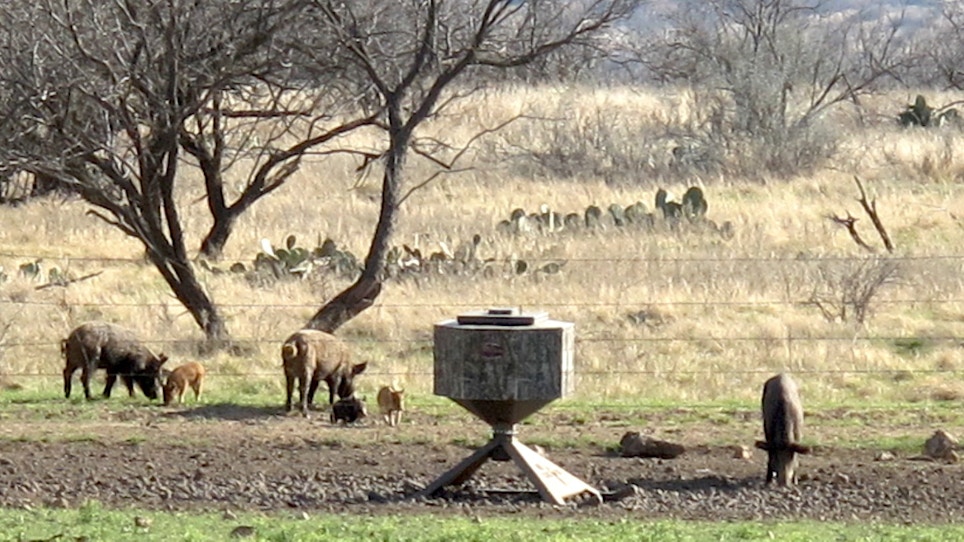
Feral hogs large and small will eat whatever is available, from corn strewn by a spincast feeder to freshly planted alfalfa or crops and even prickly pear cactus — including the spines. (Photo: Alan Clemons)
It's hard to imagine something eating prickly pear cactus, but if you've ever wonderd what feral hogs eat that's definitely one of the items on the list.
Prickly pear cactus has large, flat lobes and red fruit, all of which has a bunch of spines. The fruit has fewer than the lobes, but the spines on the fruit are smaller. The ones on the lobes are, or can be, longer and thicker. All of them hurt and cause you to say bad words if you get one in your skin.
If you're hunting hogs (or anything) in Texas and Oklahoma you'll have to deal with prickly pears. Walking, sitting, kneeling, dragging out a hog or buck, they're pretty much everywhere. Because the lobes and fruits have an internal moist pulp, hogs don't mind the spines when they're hungry enough to munch on the prickly pears. How they eat and digest it, I have no idea. No one I've ever hunted with in Texas and Okahoma did, either. "Dunno, but they do" is the common refrain.
Feral hogs are about as opportunistic as it gets when they're hungry. I've hunted them for about 30 years in seven or eight states. The first time I ever went was in east Tennessee on about 640 acres, fenced but with large holes cut on the fence perimeter. Hogs, deer and other wildlife came and went. Much of the property was covered in kudzu, which is where they noshed and relaxed to beat the heat. Thick kudzu offered enough shade, I guess, to relax but darn sure didn't deter them when they ran.
The Louisiana Department of Wildlife and Fisheries is doing a research project into the diet of feral hogs. Louisiana has enough food to sustain a small army of hogs. It's no surprise the biologists are finding plants, mast (acorns, fruit), turkey eggs and poults, rabbits, shorebirds, alligator eggs, worms, lizards and salamanders, snakes, nutria, turtles and more in the stomach analysis of the hogs.
“We’re finding everything in their stomachs,” Jim LaCour, a state wildlife veterinarian and feral hog expert, told the New Orleans Times-Picayune. “They’ll eat anything that moves — or doesn’t move. As long as it has some calories to it, they eat it. They’re in direct competition with species that we value here."
The department biologists have about 190 stomachs donated by hunters or obtained by other means. Project funding was shifted so they're in the freezer for now, but the early analysis of contents helped lend more insight.
Agriculture damage is about $80 million annually, the Times Picayune said, thanks to the hogs wreaking havoc on sugar cane, rice and sorghum crops. Throughout the Southeast and Southwest where feral hogs are most prevalent, annual crop damage is at least $1.5 billion.
Many deer hunters who plant food plots each year often see signs of hog damage thanks to the migrating swine. Corn and protein feeders on timers? The smart hogs learn quickly to gobble the nuggets (if you're a hunter, this is when you want to be there with a rifle, of course). Hogs will move to seek the best food sources, whether it's gator eggs, worms and nutria in Louisiana, a farmer's freshly planted field in Texas or tender pine saplings on property in Alabama.
Research may yield more clues about what feral hogs eat, but the easy answer is "whatever they can get their teeth into."





